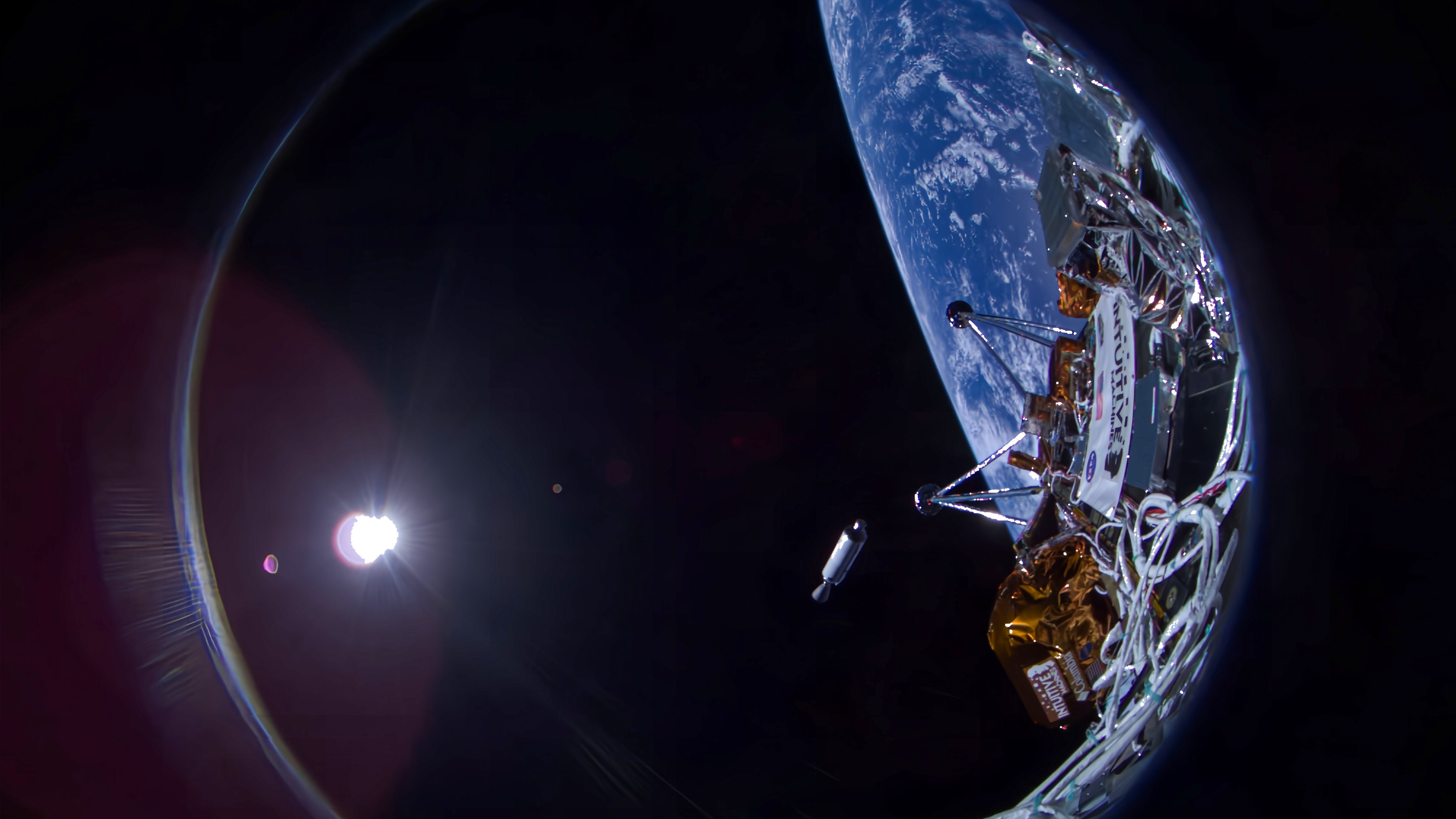
Odysseus is now circling the moon.
The robotic Odysseus spacecraft, built by Houston company Intuitive Machines, arrived in lunar orbit this morning (Feb. 21) after acing a crucial maneuver.
"Odysseus completed its scheduled 408-second main engine lunar orbit insertion burn and is currently in a 92-km [57 miles] circular lunar orbit," Intuitive Machines announced via X today.
"After traveling over 1,000,000 km [620,000 miles], Odysseus is now closer to the moon than the end-to-end distance driving across Space City, Houston, TX," the company added in another X post.
Odysseus' time in lunar orbit will be brief: The lander will try to touch down near the moon's south pole on Thursday afternoon (Feb. 22) no earlier than 5:30 p.m. EST (2230 GMT). Success would be historic: No private spacecraft has ever soft-landed on the moon, and no American vehicle has done so since Apollo 17 in 1972. You can watch the attempt here at Space.com.
Related: Missions to the moon: Past, present and future
During its lunar approach, Odysseus notched another big milestone, snapping its first photo of the moon (that we know of). Intuitive Machines shared that image via X today as well.
Breaking space news, the latest updates on rocket launches, skywatching events and more!
"Goodnight, moon. Odysseus captured this image approximately 100,000 km [62,000 miles] from the moon using its Terrain Relative Navigation camera," the company said in a post early this morning.
Goodnight, Moon. Odysseus captured this image approximately 100,000km from the Moon using its Terrain Relative Navigation camera. pic.twitter.com/wC1L9CKjdNFebruary 21, 2024
Odysseus, which is about the size of a British telephone booth, launched atop a SpaceX Falcon 9 rocket on Feb. 15, carrying 12 payloads toward the moon. Half of them are NASA science instruments, which the agency put on board via its Commercial Lunar Payload Services program, or CLPS.
CLPS aims to help NASA gather data that will advance the agency's Artemis program of crewed moon exploration, by leveraging the capabilities of private American lunar landers.
Artemis aims to establish a crewed base near the moon's south pole by the end of the 2020s. This region is thought to contain large amounts of water ice, which could be used for life support and be processed into rocket fuel to help refuel spacecraft on the go.
Odysseus' mission, called IM-1, isn't the first CLPS effort to get off the ground. Last month, Astrobotic's Peregrine lunar lander took flight on the debut mission of United Launch Alliance's Vulcan Centaur rocket. Peregrine suffered a serious fuel leak shortly after deploying from the rocket's upper stage, however, and Astrobotic ended up steering the probe into Earth's atmosphere on Jan. 18.
The other six payloads Odysseus is carrying on IM-1 belong to private customers, including Columbia Sportswear, which put some of its "Omni-Heat Infinity" insulative material aboard to give it a deep-space test.

Odysseus isn't the first private spacecraft to reach lunar orbit. For example, the Beresheet and Hakuto-R landers — built by a private Israeli team and the Tokyo-based company iSpace, respectively — both successfully circled Earth's nearest neighbor.
Both, however, crashed during their touchdown attempts, Beresheet in April 2019 and Hakuto-R in April 2023.
Editor's note: This story was updated at 6:30 p.m. ET on Feb. 21 with the new target landing time of no earlier than 5:30 p.m. ET on Feb. 22.
Join our Space Forums to keep talking space on the latest missions, night sky and more! And if you have a news tip, correction or comment, let us know at: community@space.com.

Michael Wall is a Senior Space Writer with Space.com and joined the team in 2010. He primarily covers exoplanets, spaceflight and military space, but has been known to dabble in the space art beat. His book about the search for alien life, "Out There," was published on Nov. 13, 2018. Before becoming a science writer, Michael worked as a herpetologist and wildlife biologist. He has a Ph.D. in evolutionary biology from the University of Sydney, Australia, a bachelor's degree from the University of Arizona, and a graduate certificate in science writing from the University of California, Santa Cruz. To find out what his latest project is, you can follow Michael on Twitter.
-
DrRaviSharma Why this is important mission is because it goes to Artemis 3 first human landing on moon after Apollo Program landings on which I worked.Reply
Only similar facility we had were lunar orbiters prior to Apollo and surveyor landers.
Ravi
(Dr. Ravi Sharma, Ph.D. USA)
NASA Apollo Achievement Award
ISRO Distinguished Service Awards
Former MTS NASA HQ MSEB Apollo
Former Scientific Secretary ISRO HQ
Ontolog Board of Trustees
Particle and Space Physics
Senior Enterprise Architect
SAE Fuel Cell Tech Committee voting member for 20 years.
http://www.linkedin.com/in/drravisharma
